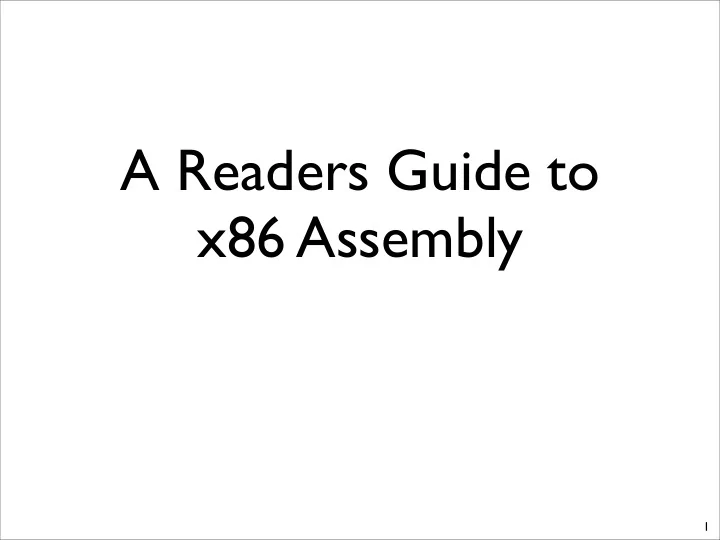

A Readers Guide to x86 Assembly 1
Purpose and Caveats • This is not a complete description! • This guide should give you enough background to read and understand (most) of the 64bit x86 assembly that gcc is likely to produce. • x86 is a poorly-designed ISA. It’s a mess, but it is the most widely used ISA in the world today. • It breaks almost every rule of good ISA design • Just because it is popular does not mean it’s good • Intel and AMD have managed to engineer (at considerable cost) their CPUs so that this ugliness has relatively little impact on their processors’ design (more on this later) • There’s a nice example here • http://en.wikibooks.org/wiki/X86_Assembly/GAS_Syntax 2
Registers 16bit 32bit 64bit Description Notes AX EAX RAX The accumulator register BX EBX RBX The base register CX ECX RCX The counter DX EDX RDX The data register These can be used more or less SP ESP RSP Stack pointer interchangeably BP EBP RBP Points to the base of the stack frame Rn RnD (n = 8...15) General purpose registers SI ESI RSI Source index for string operations DI EDI RDI Destination index for string operations IP EIP RIP Instruction Pointer FLAGS Condition codes Different names (e.g. ax vs. eax vs. rax) refer to different parts of the same register 3
Assembly Syntax • There are two syntaxes for x86 assembly • We will use the “gnu assembler (gas) syntax”, aka “AT&T syntax”. This different than “Intel Syntax” • <instruction> <src1> <src2> <dst> 4
Details Instruction Suffixes Arguments b byte 8 bits %<reg> Register s short 16 bits $nnn immediate w word 16 bits l long 32 bits $label Label q quad 64 bits ex: ‘addl’ is add 32 bits; ‘subb’ is subtract 8 bits 5
MOV and addressing modes • x86 does not have loads and stores. It has mov Instruction Meaning movb $0x05, %al R[al] = 0x05 movl %eax, -4(%ebp) mem[R[ebp] -4] = R[eax] movl -4(%ebp), %eax R[eax] = mem[R[ebp] -4] movl $LC0, (%esp) mem[R[esp]] = $LC0 (a label) 6
Addressing Modes • Addressing modes are how ISAs specify instruction operands address (any registers Operations Addressing mode could be used) needed to compute the effective address %eax 0 (%eax) n + %eax 1 n(%eax) m + %eax + %ebx * n 2 m(%eax %ebx n) n = 2^k 7
Arithmetic Instruction Meaning subl $0x05, %eax R[eax] = R[eax] - 0x05 subl %eax, -4(%ebp) mem[R[ebp] -4] = mem[R[ebp] -4] - R[eax] subl -4(%ebp), %eax R[eax] = R[eax] - mem[R[ebp] -4] • Note that the amount of work per instruction varies widely depending on the addressing mode. • A single instruction can include at least 6 additions (for the addressing mode), 2 memory loads, and one memory store. 8
Branches • x86 uses condition codes for branches • Condition codes are special-purpose, 1-bit registers • Arithmetic ops set the flags register • carry, parity, zero, sign, overflow Instruction Meaning cmpl %eax %ebx Compute %eax - %ebx, set flags register jmp <location> Unconditional branch to <location> Jump to <location> if the equal flag is set (e.g., je <location> the two values compared by cmp are equal) jg, jge, jl, jle, jnz, ... jump {>, >=, <, <=, != 0,} 9
Stack Management Equivalent instructions (but they Instruction High-level meaning take more bytes to represent) subl $4, %esp; pushl %eax Push %eax onto the stack movl %eax, (%esp) movl (%esp), %eax popl %eax Pop %eax off the stack addl $4, %esp movl %ebp, %esp leave Restore the callers stack pointer. pop %ebp None of these are pseudo instructions. They are real instructions, just very complex. 10
Function Calls Instruction High-level meaning call <label> Call the function. Push the return address onto the stack. ret Jump to the return address and pop it from the stack. leave Restore the callers stack pointer. int foo(int x, int y, • Arguments are passed on int z); ... the stack d = foo(a, b, c); • Use push to put them there. • Return value in register A push c user-friendly, push b (eax, rax, etc) not like MIPS push a call foo mov %eax, d 11
Accounting for Work addq -4(%rax), -6(%rbx) addq %rax, %rbx movl %eax, 4(%ebx) t1 = %rax-4 t1 = %ebx + 4 t2 = mem[t1] %rbx=%rbx+%rax mem[t1] = %eax t3 = %rbx - 6 t4 = mem[t1] t5 = t4 + t2 mem[t1] = t5 type count type count type count mem 3 mem 0 mem 1 arithmetic 3 arithmetic 1 arithmetic 1 12
Examples 13
Recommend
More recommend